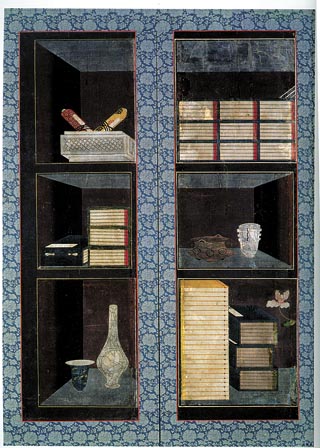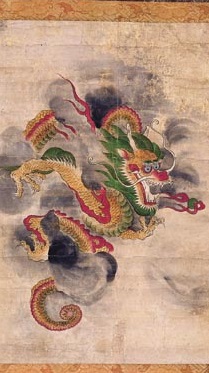Season of delicate artwork

A chaekkori screen, depicting books and other scholarly materials, from the collection of Lee Ufan. [Musee Guimet]
“Tigres de papier,” or “Paper Tigers,” is one of three exhibitions the museum has dedicated for its “Korean Season” to celebrate the 130th anniversary of diplomatic relations between France and Korea.
Two other exhibitions include an installation work that combines painting, sculpture and video by contemporary artist Lee Bae and textile artist Son In-sook’s hanbok (traditional Korean clothing), crafts and pojagi (wrapping textile) works. The exhibitions began last October and will run until Feb. 22.
Among them, the “Paper Tigers” exhibition, the largest of the three, shows visitors an overall view of original Korean paintings from the Joseon Dynasty (1392-1910).

A scroll painting titled “Dragon bondissant,” collected by Lee Ufan. [Musee Guimet]
The works include scrolls of paintings, art books and folding screens filled with panorama landscapes that are delicately painted on fine paper and silk, requiring careful handling.
When these intricate works go public, the rich and retrospective pieces are sure to mesmerize visitors.
“Is this paper or fabric?” asked a Parisian woman in her 70s looking at a wide folding screen by Korean painter Yi Han-chul, unable to touch the screens to check if the thin material on the screen was paper or not.

To celebrate the 130th anniversary of diplomatic relations between France and Korea, the Musee Guimet has organized three special exhibitions, including the largest, “Tigres de papier,” or “Paper Tigers.” [Musee Guimet]
Most of the artworks are part of the collections of Victor Collin de Plancy, a French diplomat who worked in Korea in the 19th century, and some are from collector Charles Varat as well as donations from Korean artist Lee Ufan.
What captivates most foreign visitors are the abundant yet diverse expressions of animals representing power, such as tigers and dragons, on the scrolls and folding screens.
And the smallest details, such as the feathers of birds sitting on a branch, are so carefully depicted that they are a constant source of surprise to most visitors.
The Musee Guimet started with passionate interest by its founder, French industrialist Emile Guimet (1836-1918), in the history of religion, bringing together works illustrating the world’s religious beliefs.
The museum has a vast collection of religious artwork from Korea dating from the 14th to 20th century.
The pieces allow visitors to compare different styles in religious paintings that illustrate Korean shamanism, Confucianism and Buddhism. Calligraphy showing the eight virtues of Confucianism written in large characters across folding screens, as well as paintings showing Korean noblemen’s imaginary study and writing supplies, reveal how people of the Joseon Dynasty liked to flaunt their intelligence.
“Among the artworks on display, I appreciated the paintings the most,” said a French visitor, Anne-Marie Hurlin. “I learned a couple of things from them, such as that there must be a lot of mountains in Korea, which I was not aware of before. But I noticed them used as motifs in many of the paintings. I was also a bit surprised to learn of the significance of tigers as shown in the paintings.”

Armoire basse from the Joseon era. [Musee Guimet]
BY YIM SEUNG-HYE
[yim.seunghye@joongang.co.kr ]










with the Korea JoongAng Daily
To write comments, please log in to one of the accounts.
Standards Board Policy (0/250자)